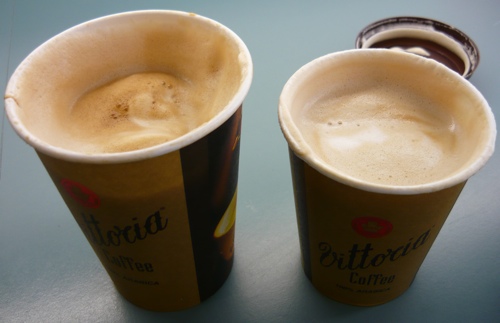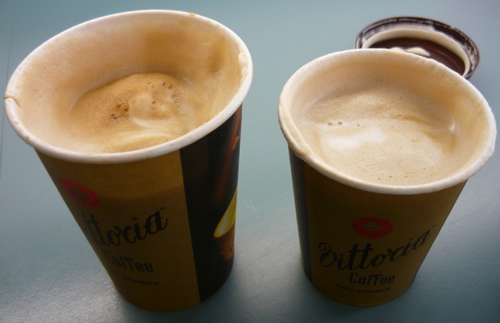Australia is, I think, the home of the Flat White – a coffee that is a bit like a latte with less milk and that has quite recently started infiltrating the UK coffee scene. Of course, Monmouth at Borough Market has been doing a very good flat white for a few years, but then again, in my view, Monmouth at Borough Market is the BEST place for coffee in the UK (there is a chance my sampling is not exhaustive).

Anyway, we have just completed a blinded randomised comparison of a regular flat white with a large one. My hypothesis was that the regular is better. We made the fundamental flaws of not defining our primary outcome variable a-priori, and one subject was definitely influenced by the apparent temperature of the drink, and reported her perceptual response in a manner that implies she was heavily influenced by things other than taste (that is, she said ‘oh, that is the small one’). Her data were removed from analysis. The remainder of reports were more clearly confined to the key taste related variables of ‘stronger’, and ‘flat-white-ier’. The group data clearly showed that regular sized flat whites are less strong, but ‘nicer’, than large flat whites. Not that removing the size, shape, weight and temperature of a beverage provides a more accurate measure of taste – we can just ask Charlie Spence that foods that sound better taste better – here is his latest paper…..STAY TUNED THOUGH – next post is the first author of this paper – Anne-Sylvie – talking about it. It is a great post come back for it….
A sweet sound? Food names reveal implicit associations between taste and pitch
Sounds (high- and low-pitched) have been shown to be implicitly associated with basic tastes (sour and bitter-see Crisinel and Spence, 2009 Neuroscience Letters 464 39-42). In the present study, a version of the implicit association test was used to assess the strength of the association between high-pitched sounds and names of sweet-tasting foodstuffs, and between low-pitched sounds and names of salty-tasting foodstuffs (experiment 1). A similar task, the go/no-go association task was then used to evaluate the relative strengths of these associations (experiment 2). Analysis of the sensitivity of participants’ responses suggested that both sour- and sweet-tasting (names of) food items were associated with high-pitched sounds. This result highlights the existence of robust cross-modal associations between certain sounds and basic tastes.

Crisinel AS, & Spence C (2010). A sweet sound? Food names reveal implicit associations between taste and pitch. Perception, 39 (3), 417-25 PMID: 20465176



